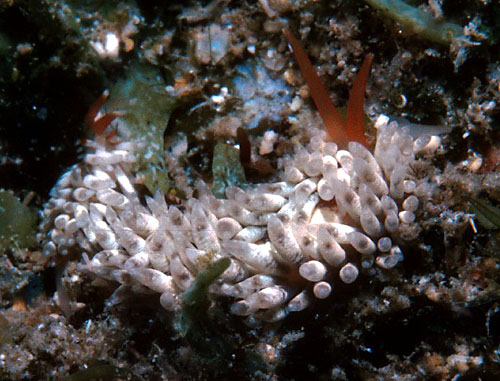| Home |
| Acknowledgments |
| Conventions |
| Glossary |
| Maps |
| References |
| Links |
| Articles |
| Thumbnails |
| Species
list |
| Family |
| Next
species |
Additional Photos

young, 4 mm

Anteaeolidiella cf. takanosimensis (Baba, 1930)

| Maximum size: ( ) Identification: This species has closely spaced rhinophores and laterally directed cerata. The body is cream, tinted with a large white patch behind the head. Extensive white pigment on the cerata obscure the cnidosacs. Subapical "windows" in the white pigment create dusky patches on the outer faces of the cerata. The rhinophores are orange-red with small white tips. The white pigment may be less extensive in small juveniles. (Note 1) Natural history: Anteaeolidiella cf. takanosimensis is known from two animals found at a depth of about 0.5 m (1.5 ft) at an exposed, rocky site. A third, juvenile, animal was found at a highly exposed rocky site at between 3 and 7.6 m (10 and 25 ft). Distribution: Maui and Oahu: Anteaeolidiella takanosimensis is known from Japan. Taxonomic notes: It was first recorded in Hawaii from Makua, Oahu by Scott Johnson on Sept. 19, 1979. The lack of red-orange tips and the more extensive white frosting on the cerata distinguish the Hawaiian animals from those found in Japan. Photo: Scott Johnson: pair: Makua, Oahu; Sept. 19, 1979. Observations and comments: Note 1: The 4 mm juvenile from Maui is tentatively assigned to this species since the developing white pigment is lower on the cerata than would be expected in Anteaeolidiella cacaotica while the markings on the rhinophores and habitat match Anteaeolidiella cf. takanosimensis. |
| Thumbnails |
Species
list |
Family | Next species | Top |